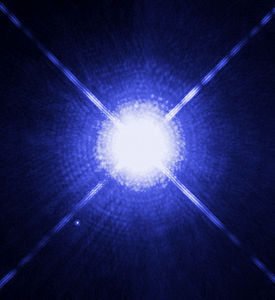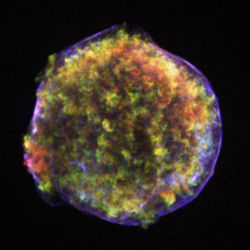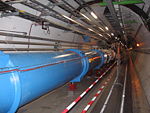Portal:Physics
2008/9 Schools Wikipedia Selection. Related subjects: Physics; Portals; Science
Physics (from Greek φυσική / physikê means science of nature) is the science concerned with the discovery and understanding of the fundamental laws which govern matter, energy, space, and time. Physics deals with the elementary constituents of the universe and their interactions, as well as the analysis of systems best understood in terms of these fundamental principles. Because physics treats the core workings of the universe, including the quantum mechanical details which underpin all atomic interactions, it can be thought of as the foundational science, upon which stands " the central science" of chemistry, and the earth sciences, biological sciences, and social sciences. Discoveries in basic physics have important ramifications for all of science.
Classical physics traditionally included the fields of mechanics, optics, electricity, magnetism, acoustics and thermodynamics. Modern physics is a term normally used to cover fields which rely on quantum theory, including quantum mechanics, atomic physics, nuclear physics, particle physics and condensed matter physics. The more recent fields of general and special relativity are also usually placed within this category. Although this distinction can be commonly found in older writings, it is of limited current significance as quantum effects are now understood to be of importance even in fields previously considered purely classical.
Physics research is divided into two main branches: experimental physics and theoretical physics. Experimental physics focuses mainly on empirical research, and on the development and testing of theories against practical experiment. Theoretical physics is more closely related to mathematics, and involves generating and working through the mathematical implications of systems of physical theories, even where experimental evidence of their validity may not be immediately available.
A white dwarf, also called a degenerate dwarf, is a small star composed mostly of electron-degenerate matter. As white dwarfs have mass comparable to the Sun's and their volume is comparable to the Earth's, they are very dense. Their faint luminosity comes from the emission of stored heat. They comprise roughly 6% of all known stars in the solar neighbourhood The unusual faintness of white dwarfs was first recognized in 1910 by Henry Norris Russell, Edward Charles Pickering and Williamina Fleming, and the name white dwarf was coined by Willem Luyten in 1922. White dwarves continue to lose energy and fade, becoming Black dwarfs...
A false colour image of Tycho's Supernova Remnant, of Tycho's Supernova of 1572.
- ...that in the Large Hadron Collider (LHC) (pictured) protons, accelerated to the energy of 7 TeV, move at 99.999999% of light speed and become 7,500 times heavier than at rest?
- ...that, at a speed of 299,792,458 m/s, light can travel to the Moon in 1.2 seconds?
- ...that the submarine telescope ANTARES, intended to detect neutrinos, may also be used to observe phosphorescent plankton and fish?
- ...that lasers can be used to separate two isotopes very efficiently?
- ...that neutron stars are so dense that a teaspoonful (5 mL) would have more mass than every person on Earth?
- ...that every year, the Moon moves 3.82 cm away from Earth?
- ...that gold leaf is about 500 atoms thick?
|
|
|
|
|



